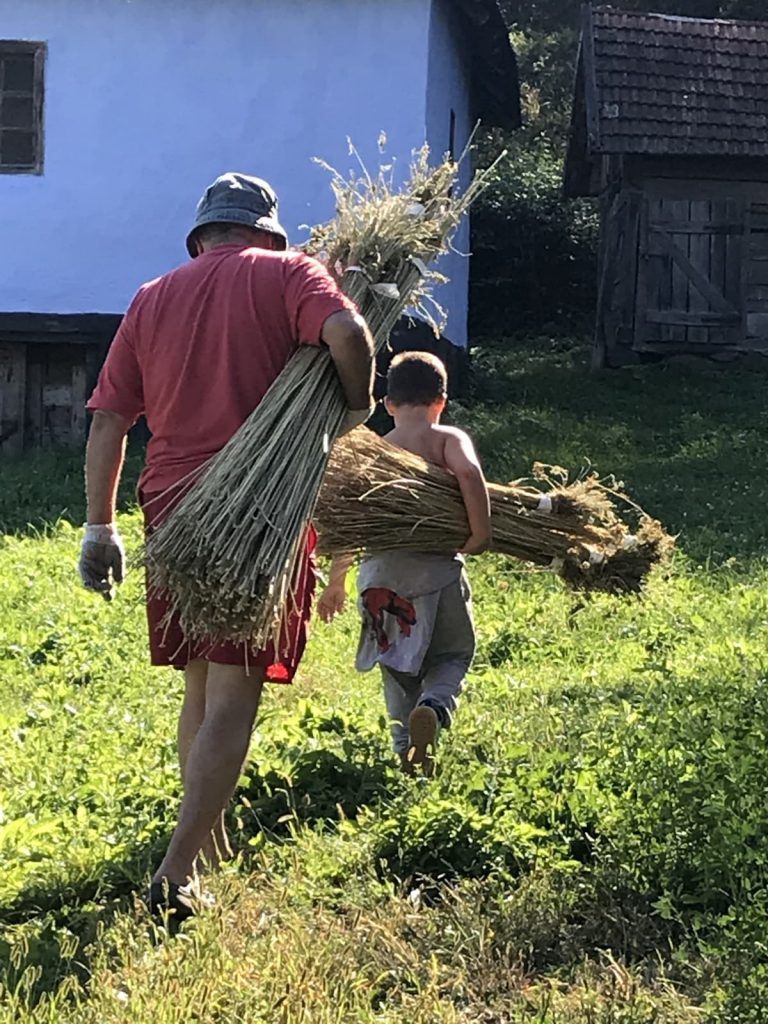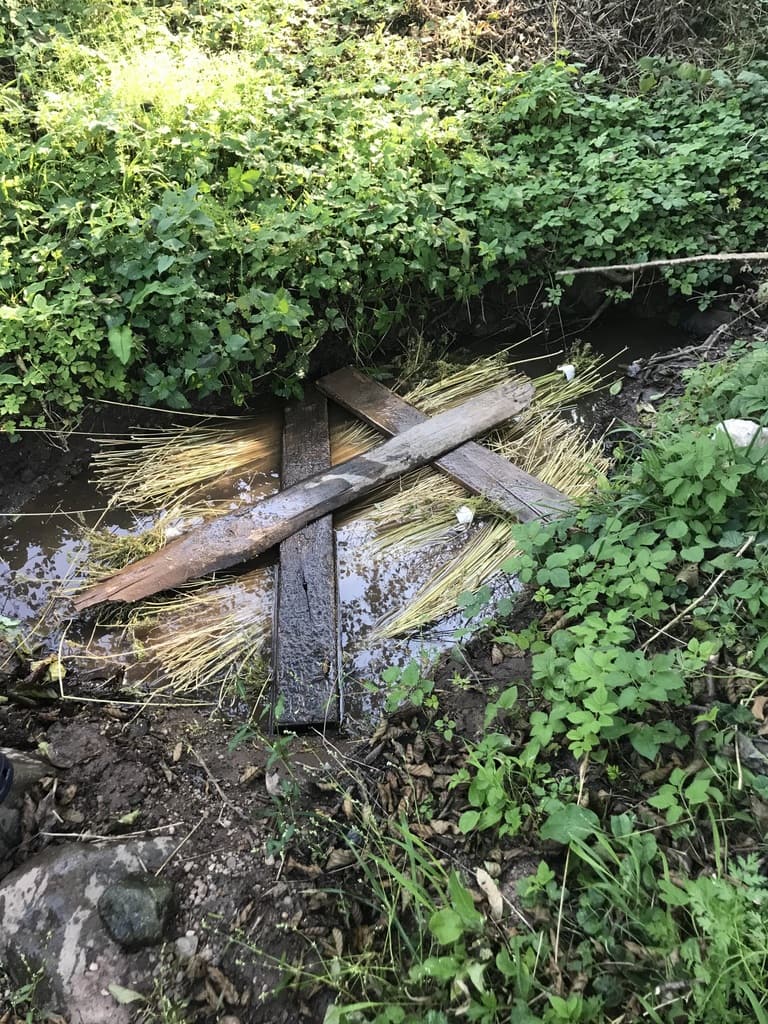We want to share with you beautiful research on the traditional technology of hemp fibers in the villages of the Apuseni Mountains and the surrounding area in Romania. The focus of the research was on the processing of the summer hemp, from cultivation to finished textile.
The researcher, Mrs. Florica Zaharia, started her project in 1989 in the mountain villages where the women working in the textile home industry were going at it for decades. This was an important step to make, in order for her to learn the essentials steps in traditional hemp fiber production.
The research stretched on more than 10 years, gathering information from the collective experience of a generation of women in their seventies and eighties as well as their parents' knowledge. All of this impacted the research chronologically, taking it back to the second half of the nineteenth century.
About Romanian hemp (cânepă)
Hemp (Cannabis Sativa) or as we call it in Romanian ‘’cânepă’’, is an annual plant with some specific characteristics: tall straight stem, the leaves are digitate, with five to thirteen lobes and the flowers are greenish-yellow. It’s also important to mention that there are two types of hemp plants in the same crop: the male which mature and are harvested in summer (summer hemp) and the female plants which mature and are harvested in the autumn. The main difference is in their appearance, and usually, the proportion of both summer and autumn hemp in a crop is approximately equal. Two interesting things here: the textile fibers represent 15-26% of the weight of the dry stems of both kinds and the seeds for the next year are collected from the matured autumn plants.
The usage of hemp fibers in the Romanian geographical territory goes back to the time of the Dacians and Thracians tribes, as the Greek historian Herodotus and other historical sources mention. There were also a couple of archeological discoveries at Garvan-Dinogeția that showed evidence of hemp clothing between the 11th and 13th centuries. Beginning with the 18th century, written sources and documents connected with the use of hemp fibers are abundant.
Things changed a lot in the 20th century. In the first half of the century, each family had their own hemp crop which could be woven approximately 30 meters of fabric, that could be used for clothing, tablecloths, bedclothes, and even bags. When the use of cotton increased, around the middle of the century, the quantities per family decreased. This was also affected by the prices coming down. Nowadays, the cultivation of hemp in the context of the home textile industry is extremely rare in Romania.

The Experiment
Because of the lack of cultivated hemp in the Apuseni Mountains, Florica started her own crop in the Hartagani village, with the aim of recreating and document the technological process. The experiment started with the planting phase in April.
The harvesting of the summer hemp occurred in 12 weeks at the end of July, just after they were shaken in order to release the pollen and the leaves were starting to turn yellow. As for the hemp stems, they were tall around 150 cm and thin.
The autumn hemp matured around three or four weeks later, practically at the end of August or beginning of September. Some differences could be observed between the two strains: the color of the leaves were dark green, the flowers bright green, the stem thick and approximately 180 cm, and the fibers longer, thicker, tougher.
The method of harvesting is the same for all the categories of hemp. Women used their arms for the whole process: with one hand they pulled individually each plant and with the other hand they collected the hemp. One bunch was called ‘’mănușă’’ and was equal to the number of plants that could be in two hands.
Another category of hemp plants that were also harvested during autumn were the ‘’hăldani’. The stems were 200 cm and up, and the plants from this group were heavily branched. They were used mostly for making rope or string.
The Retting Process
Hemp drying normally begins after the harvesting by leaving it to dry in the sun on a fence for two days. The autumn one is dried more carefully in the field where the seeds are collected. For each category of hemp, the leaves and the flowers are shaken before the retting starts. During the retting process, the pectin that attaches the fibers to the wooden stem dissolves, and the fibers are released. There are two ways in which hemp can be retted: in running water or a pool created near running water that can be easily filled. Both methods give similar results.
The retting process is considered done when the stems broke easily and the fibers could be separated from the stems. After retting each mănușă had to be washed in cold water in order to eliminate the decomposed part of the plant.

Hemp Braking
Hemp braking happens after so that the separation of the fibers from the wood is complete. For this process to happen, it’s imperative that the hemp is very dry and should be done on a sunny day with very low humidity. A meliță (the brake) is a 75 cm grooved piece of wood set on a support, with a wooden blade attached at one end by a wooden nail that allows it to function freely. It starts with the stems of the hemp being cracked on the brake, then between the groove and the blade thus resulting in the fibers being released. When one end of the bunch gets very well braked the fibers are rolled in one’s hand and the other end gets braked. The small remains of the wooden pith are scutched by shaking the fibers. After that, the bunches of fibers (called fuioare), are twisted and folded in half in order to keep them neatly arranged.
Hemp Carding
In this experiment, three types of fibers were obtained. For the process, three cards called piepteni made out of wood with iron teeth were used. Each card had a different role, ranging from separating the fibers to combine the fibers to become finer.
A first card is immobilized to a bench in order to obtain the fuior, with one end of the mănușă rolled around one hand and the free end combed on the card. When the hemp fibers were no longer retained on the card, the combed part of the fibers was knotted and the same process was repeated with the other end. In order to make the hemp finer, the bundle was then combed with the last card.

Hemp Spinning
The spinning normally happened during late autumn or winter but could be done any time all year round. In the experiment, the hemp yarn was placed in the Z direction and highly twisted so that it would be strong enough for the whitening process that followed. Only traditional methods and tools were used for the spinning process.
Some tools used in the process:
- a simple distaff - a 150 cm stick made of a filbert, a wood that is light, strong, and straight. To make the bundle, the hemp is laid flat and the upper part of the distaff placed in a horizontal position on top of the hemp. The fibers are rolled around the distaff and held in place by the string twisted around it and tied at the bottom end.
- the spindle - a short stick (around 40 cm) carved out of one piece of soft willow wood.
When a woman spins, she holds the distaff between her knees and feet. With her left hand, she supplies the hemp, thus controlling the thickness of the yarn. With her right hand, she twists the spindle clockwise, keeping it in a vertical position with the sharpened end up.
She also moistens the fibers with saliva and holds the spindle between her thumb and first two fingers at the interior side, and forefinger and middle fingers on the outside. The spindle is moved by pushing or rolling it in a clockwise direction of the thumb and the forefinger, while the middle and ring finger hold it in place.
After spinning, the yarn was made into skeins called jirebii and stored until the next process, the bleaching and softening.
Bleaching and softening hemp yarn
The bleaching and softening of hemp fibers were done in two steps.
Step 1.
The skein yarn was bleached before weaving, a process done with ashes and water.
Step 2.
The hemp was woven into cloth, dipped in water, and bleached by the sun. An exception to the bleaching was the hemp warp used to weave tapestry with wool weft.
First bleaching is necessary and is usually done in a hollow tube made out of willow, called pârlău. But before this process starts, preparation is mandatory: the skeins are dipped in cold water, the pârlău is set on support, covered with wooden boards, an empty receptacle called troacă, boiling water kept in a căldare (bucket type of recipient). The pârlău is also filled at the bottom with a thin layer of straws and after some closely packed alternated layers of yarn and ash obtained from plum or beech wood. The ashes can be from any type of wood, except walnut trees because of their acidity.
In the experiment, the pârlău was filled with 20 cm yarn of hemp along with some hemp chemises, all covered with a big piece of hemp material called cenușer and a thick layer of ash (10 cm).
The bleaching is achieved by pouring very high alkaline water, called leșie, heated up to high temperature. It usually takes two hours for the bleaching to be complete and the process repeats itself six times. After this, the bleached hemp is dried outside in the sun. After that, the yarn or cloth should be softer and lighter in color.
Hemp Dyeing
Very rarely, hemp fibers were dyed to be used specifically in the decoration of hemp towels or tablecloths. The yellow color was made traditionally of ferrous oxide, called galițoi, and ash was considered very good. There was also black dye used, made from tannin extracted from the bark of Alnus glutinosa trees and mixed with galițoi.
The Use of the Hemp Fibers
The most important categories of textiles made with hemp fibers were plain weave or twill cloth, made exclusively with hemp, or in combination with cotton which became popular around 1920 and was used for towels, tablecloths, bedclothes, costumes, or as warp for the decorative bed covers.
This whole research surfaced the fact that hemp played an important part in the rural Romanian world and that this knowledge is in jeopardy of fading in history. We were inspired by old traditions and stories about it, in our De IONESCU endeavor to revitalize the Romanian hemp. We felt that it is important to share with you some researchers that inspired us to become what we represent today.
1. Hemp Plants (Research Project, Romania 2018)
2. Hemp Plants (Research Project, Romania 2018)
3. Harvesting the Summer Hemp (Research Project, Romania 2018)
4. Drying the Harvested Hemp (Research Project, Romania 2018)
5. Removing the summer Hemp's roots (Research Project, Romania 2018)
6. Dried hemp, Ready for retting (Research Project, Romania 2018)
7. Retting the Summer Hemp (Research Project, Romania 2018)
8. Retting the Summer Hemp, detail (Research Project, Romania 2018)
9. Retted Hemp (Research Project, Romania 2018)
10. Drying the retted Hemp (Research Project, Romania 2018)
This article represents an adaptation of Mrs. Florica Zaharia’s project named ‘’Research on traditional technology of hemp fibers in Apuseni Mountains, Romania’’.
For more, please visit http://www.muzeultextilelor.org/en/



1 comment
Thank you for making this information available. As a student of hemp fiber, this is very useful information.
Leave a comment